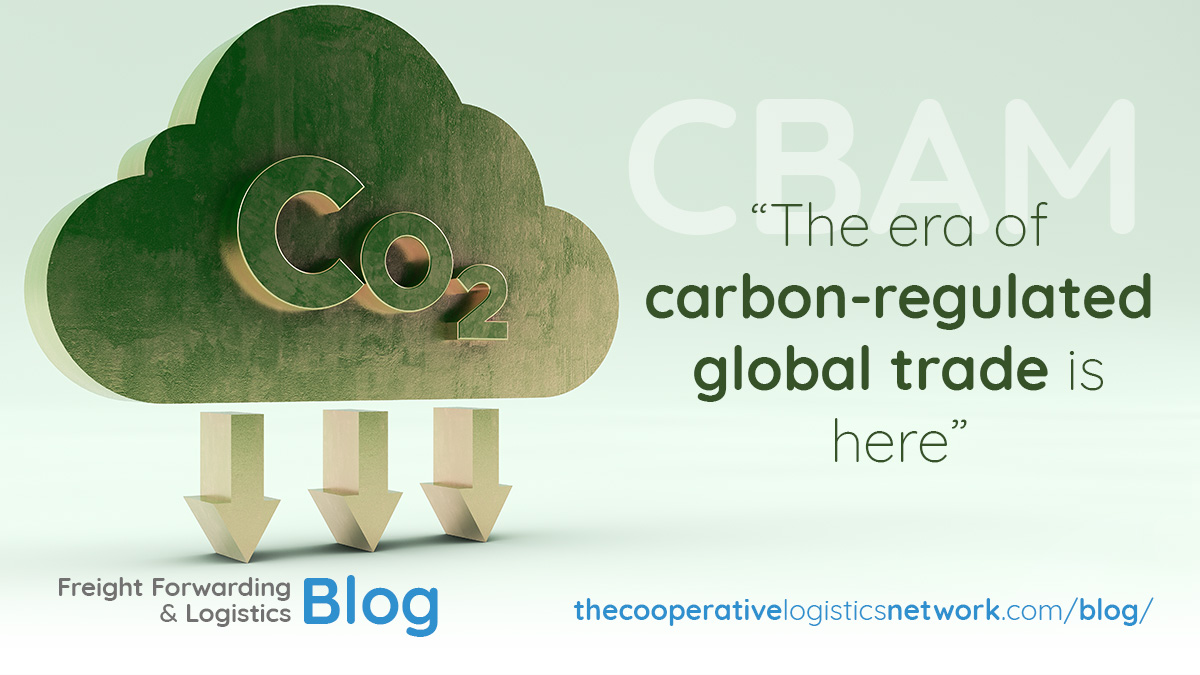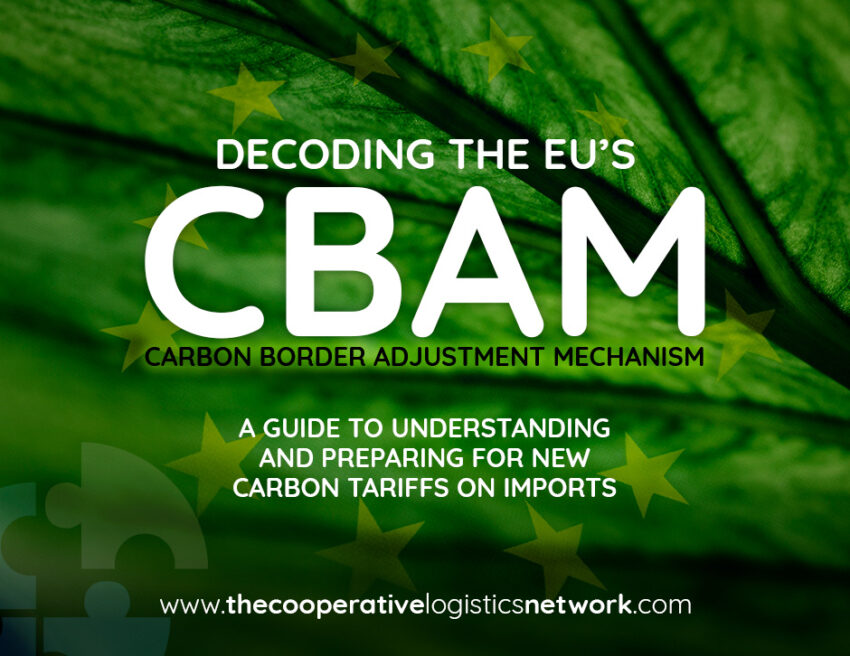As the world accelerates its shift toward decarbonization, the European Union has introduced one of the most ambitious climate policies to date: the Carbon Border Adjustment Mechanism (CBAM). For freight forwarders involved in international trade, this new framework is more than just a distant policy—it has immediate implications for import processes, documentation, and client communication.

The CBAM is not just a regulatory hurdle for importers. It’s also a wake-up call for logistics providers to become more deeply involved in sustainability and carbon compliance. This blog breaks down what the CBAM is, why it matters, and how freight forwarders can navigate its impact on global supply chains.
What is CBAM and why was it introduced?
The Carbon Border Adjustment Mechanism is the EU’s answer to a growing concern: carbon leakage. This occurs when European companies, subject to strict climate rules under the EU Emissions Trading System (EU ETS), relocate production to countries with laxer environmental standards. CBAM is designed to level the playing field by placing a carbon price on certain imported goods, mirroring the cost EU producers already bear under the ETS.
In simple terms, the CBAM ensures that imported goods are taxed based on their embedded carbon emissions, with the goal of encouraging greener manufacturing globally while protecting European industries from unfair competition. Launched in its transitional phase in October 2023, CBAM initially targets six high-carbon sectors: cement, iron and steel, aluminum, fertilizers, hydrogen, and electricity. Over time, this list may expand, especially as the EU tightens its net-zero targets.
Why freight forwarders should pay attention
You might be thinking: “Isn’t this just a tax issue for importers?” On the surface, yes. But in practice, CBAM impacts the day-to-day operations of freight forwarders in several ways.
Firstly, forwarders are deeply involved in customs processes and documentation. With CBAM, there’s now a new layer of complexity. Importers must report carbon emissions data for each shipment falling under the CBAM scope, and in many cases, they will rely on their logistics partners to provide or verify emissions data, shipping details, and certificates of origin.
Secondly, CBAM compliance will affect routing decisions, cost estimates, and timelines. If a shipment of steel from a non-EU country incurs a CBAM charge, freight forwarders may be asked to explore alternative suppliers, adjust shipment timing, or provide options that minimize exposure to the new tariffs.
Lastly, freight forwarders who understand CBAM and can guide clients through its challenges will stand out as trusted, knowledgeable partners in an increasingly regulated trade environment.
CBAM’s transitional phase: What’s happening now?
From October 1, 2023, to the end of 2025, the EU is implementing a transitional phase of CBAM. During this period:
-
No financial payments (carbon taxes) are required yet.
-
Importers must report emissions data quarterly on the embedded emissions of goods they bring into the EU.
-
The aim is to familiarize businesses and customs authorities with the data collection process before monetary obligations kick in starting 2026.
This phase gives freight forwarders a crucial opportunity to build internal processes and train staff on the reporting requirements. If you’re moving goods in any of the covered categories, now is the time to work with clients to identify their CBAM exposure and set up reporting systems that will allow for a seamless transition once the mechanism becomes fully operational.
What information will be required?
The key deliverable under CBAM is a quarterly report, submitted by the EU importer (or the “CBAM declarant”). This report includes:
-
Quantity of goods imported
-
Country of origin
-
Method of production (if available)
-
Embedded emissions (both direct and indirect)
-
Carbon price paid in the country of origin (if any)
Here’s where freight forwarders come in. As key facilitators of international cargo movements, you will be the bridge between foreign producers, customs brokers, and EU importers. Clients may turn to you to obtain emissions declarations from suppliers, manage certificates of origin, or align shipment data with the necessary CBAM formats.
Some forwarders are even beginning to bundle CBAM advisory services into their logistics offerings—an emerging niche with growing demand.
Preparing for 2026: The real CBAM begins
The real teeth of CBAM arrive in January 2026, when importers will be required to purchase and surrender CBAM certificates that correspond to the embedded emissions in their imported goods.
This means:
-
Importers must open a CBAM Registry account with EU authorities.
-
They will need to calculate emissions based on EU-approved methodologies.
-
Each year, they will buy enough CBAM certificates to cover the emissions tied to their imports, priced according to the weekly average of EU ETS carbon allowances.
For freight forwarders, this brings a new wave of responsibility. You may be asked to help clients identify the carbon impact of each shipment, consult with foreign manufacturers, or offer lower-emissions transport options that reduce CBAM exposure.
Being CBAM-aware also means helping clients choose the right Incoterms. For instance, an importer using DDP (Delivered Duty Paid) may shift more responsibility for carbon compliance onto the forwarder or logistics provider. Understanding these legal nuances is vital.
Geographic impact: Who’s most affected?
CBAM’s impact will be felt most strongly by exporters to the EU from countries without their own carbon pricing systems. This includes many developing countries, where access to clean production technologies is limited.
For freight forwarders working with clients in places like China, India, Southeast Asia, and the Middle East, CBAM compliance could become a serious trade barrier. Not only will these clients face increased costs, but they may also struggle to provide emissions data required by the EU.
Here, forwarders can play a pivotal role in educating shippers and helping them gather accurate emissions data—possibly even advising on greener production methods or collaborating with suppliers who use lower-emission processes.
Turning compliance into competitive advantage
Rather than viewing CBAM as a burden, forwarders should see it as an opportunity to enhance their value proposition. Those who stay ahead of the regulation, build emissions tracking into their systems, and offer CBAM guidance will become indispensable to EU-bound clients.
Many forwarders are already investing in digital platforms that track emissions by shipment, offering emissions data per route or carrier, and even integrating carbon offsets as part of their services. These tools not only simplify compliance—they also resonate with clients who are striving to meet their own ESG goals.
In fact, being CBAM-compliant could become a major selling point in tender processes, particularly with large clients who want to future-proof their supply chains.
Conclusion: The future is carbon-regulated
CBAM is a clear signal that the era of carbon-regulated global trade is here. For freight forwarders, it represents both a challenge and a transformative opportunity. While navigating this new policy will require investment in systems, training, and partnerships, those who embrace it now will be in a prime position to serve the climate-conscious logistics of tomorrow.
Whether you’re a small forwarder moving steel by ocean freight or a global player managing multimodal imports into Europe, CBAM is a call to evolve. Understanding it today could mean thriving in the sustainable trade lanes of the future.


